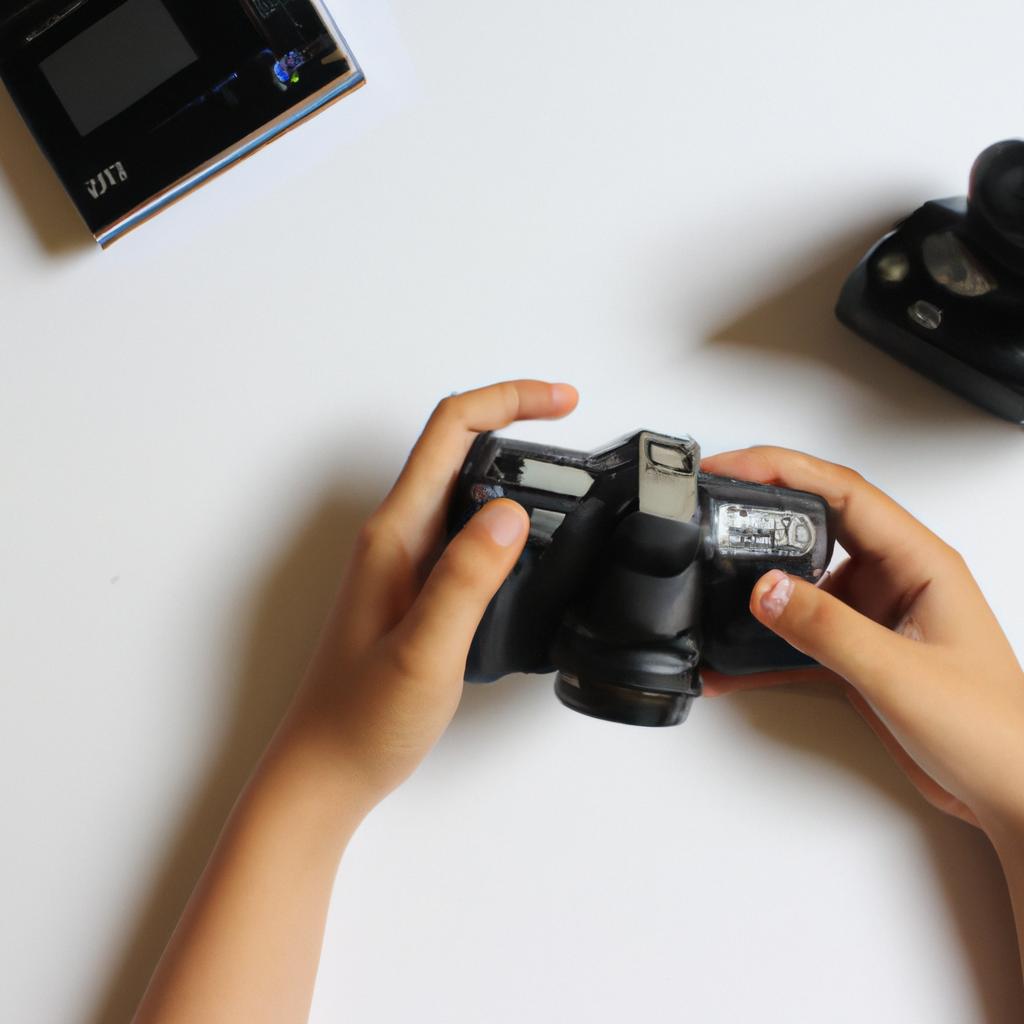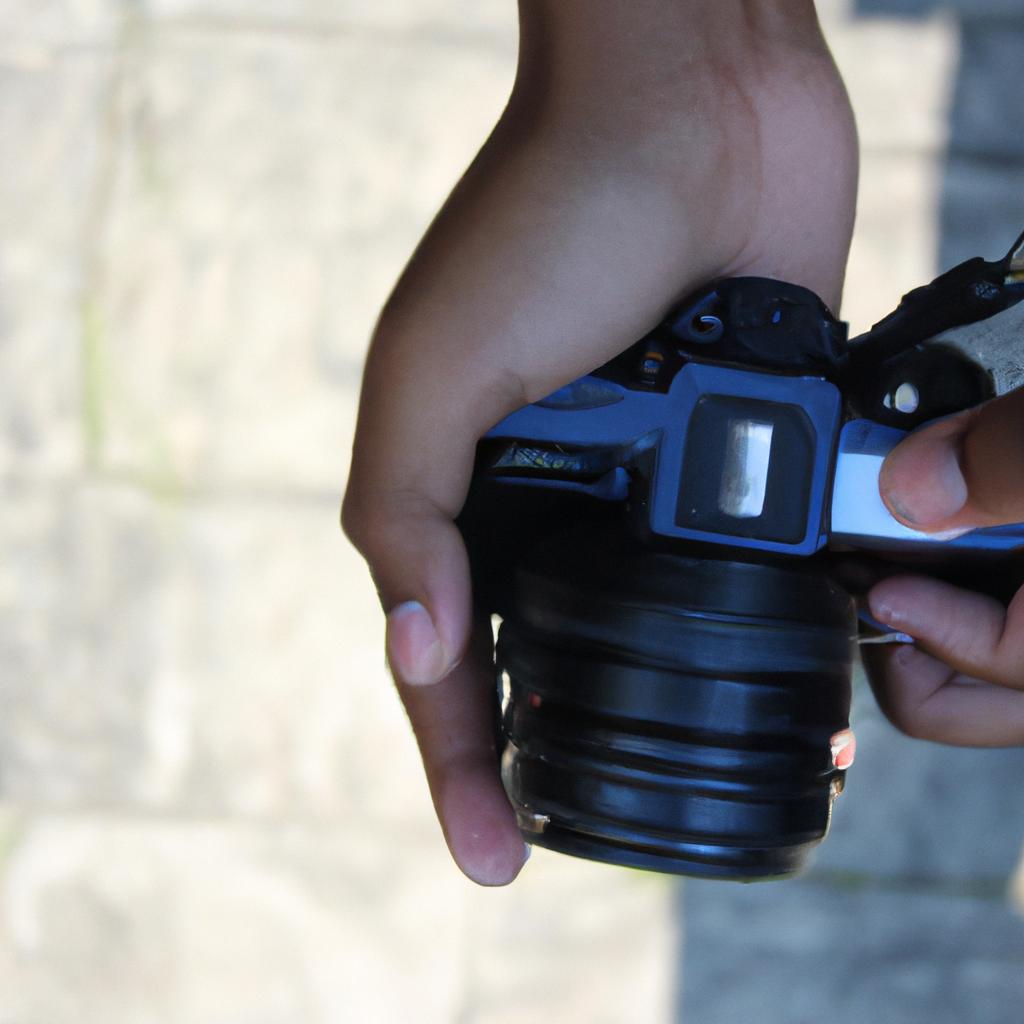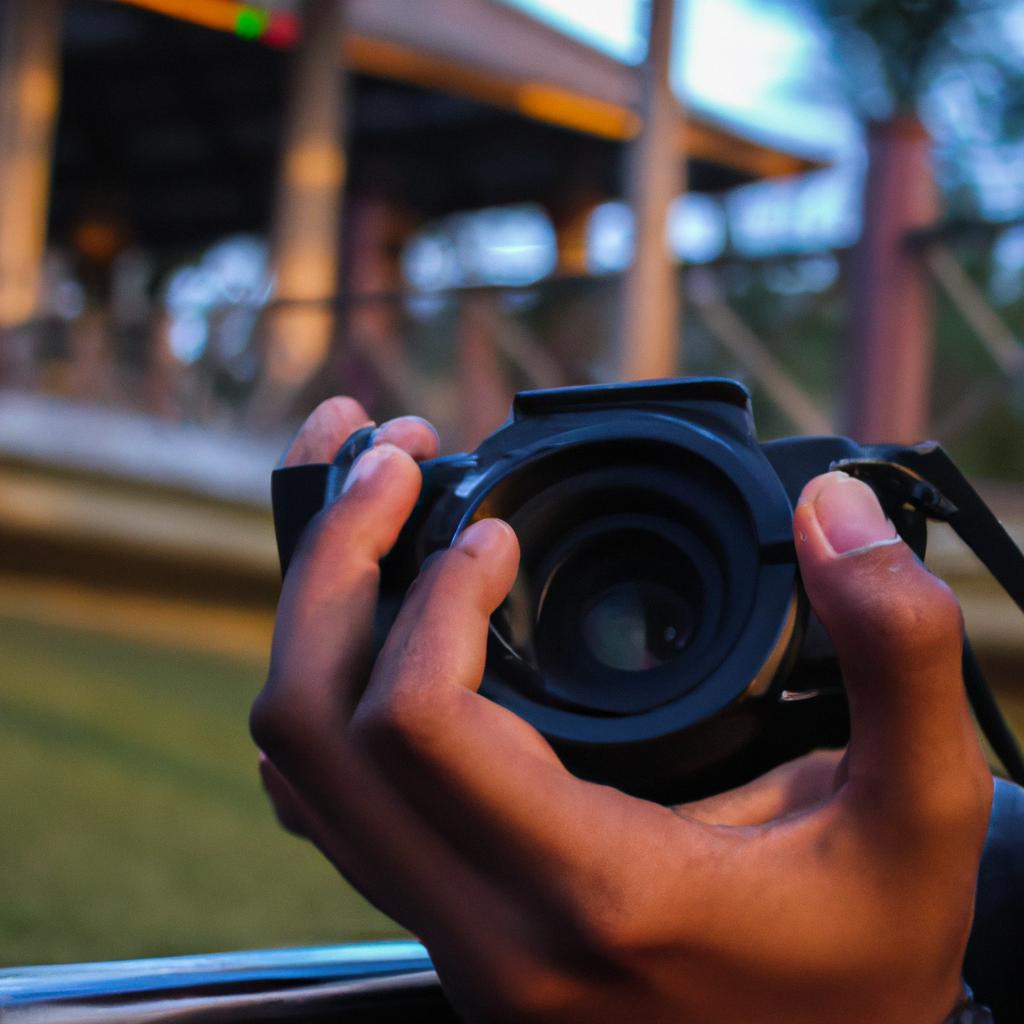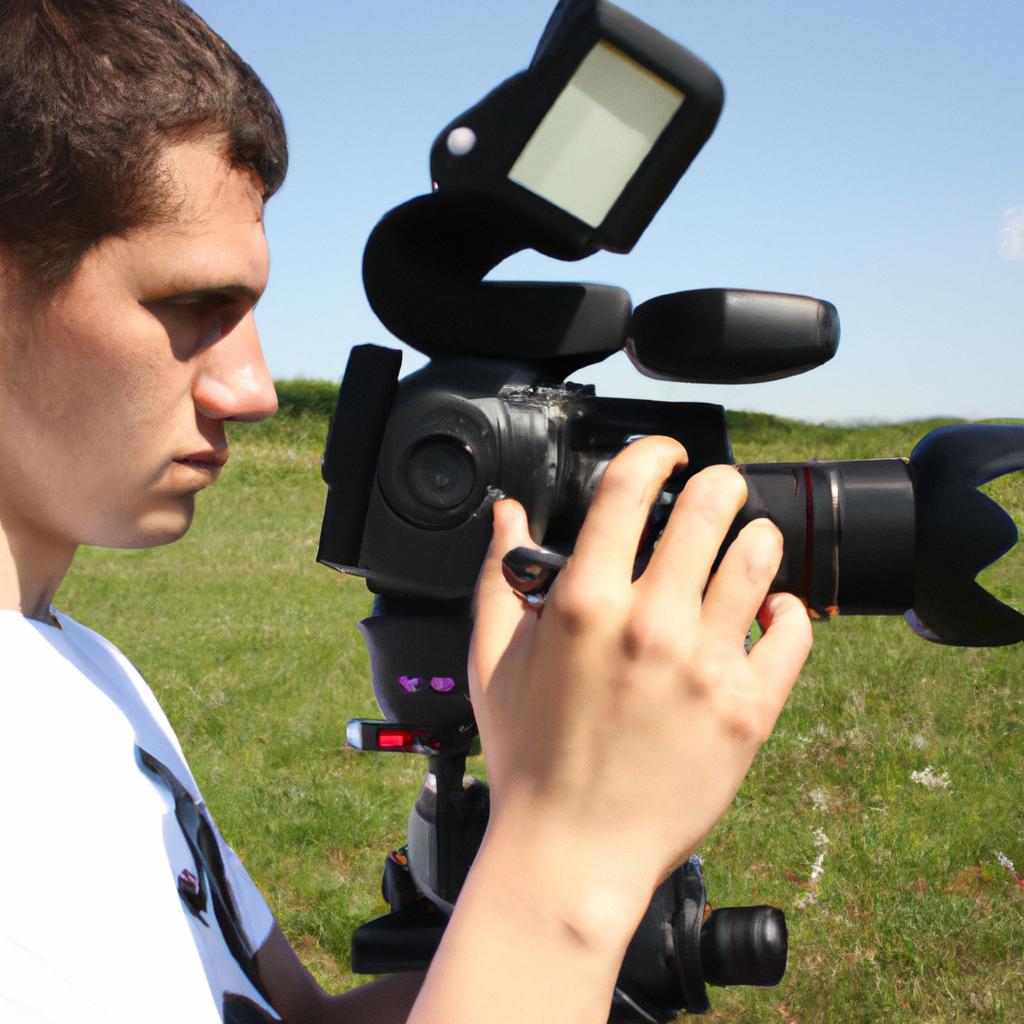Still life photography is a captivating and often overlooked art form that has found its way onto the screens of television in recent years. This genre, characterized by carefully arranged objects and compositions, offers a unique visual experience for viewers. One compelling example of still life photography on television can be observed in the hit series “Mad Men.” In this show, the meticulous attention to detail in capturing everyday objects and settings not only enhances the overall aesthetics but also contributes to character development and storytelling.
The inclusion of still life photography on television showcases the artistic prowess behind the camera as well as the creative intentions of directors and cinematographers. By focusing on mundane objects such as office supplies or household items, these photographic moments offer a fresh perspective on daily life. Moreover, they create opportunities for symbolic representation and narrative depth within each frame. Through careful composition and lighting techniques, these photographs become more than just pleasing visuals; they enhance storytelling by providing additional layers of meaning and creating an immersive viewing experience.
In this article, we will explore the significance of still life photography in television and its impact on audience engagement. We will delve into how this specific technique adds depth to characters’ stories while simultaneously contributing to visual aesthetics. Additionally, we will examine notable examples from various TV shows that have successfully incorporated still life photography to illustrate their narrative themes and enhance the overall viewing experience.
One notable example of still life photography in television can be found in the critically acclaimed series “Breaking Bad.” Throughout the show, there are numerous instances where everyday objects are meticulously arranged and captured in a way that adds layers of meaning to the story. For instance, in one episode, a close-up shot of a fly buzzing around a meth lab symbolizes the protagonist’s deteriorating mental state and his obsessive pursuit of perfection. This simple still life photograph effectively conveys the character’s internal struggle and foreshadows future events.
Another compelling use of still life photography can be observed in the popular series “Stranger Things.” In this show, carefully composed shots of nostalgic objects from the 1980s, such as cassette tapes, arcade games, or vintage toys, not only create an immersive retro atmosphere but also serve as visual storytelling devices. These photographs evoke a sense of nostalgia and help establish the time period while simultaneously reflecting characters’ personalities and interests.
Furthermore, still life photography has been utilized in shows like “Sherlock” to depict forensic evidence or clues within crime scenes. By capturing these objects with precision and attention to detail, viewers are encouraged to engage actively with the narrative by examining the photographs for potential insights or connections. This technique enhances audience involvement, making them feel like they are part of solving the mysteries alongside the characters.
In conclusion, still life photography in television is an artistic technique that goes beyond aesthetics; it serves as a powerful tool for storytelling and audience engagement. By carefully arranging everyday objects and capturing them with intentionality, this genre contributes to character development, symbolic representation, and immersive visual experiences. Whether it is used to convey emotions, establish time periods, or invite audience participation in solving mysteries, still life photography adds depth and significance to television narratives.
The History and Evolution of Still Life Art on Television
The History and Evolution of Still Life Art on Television
Television has long been a platform for showcasing artistic expression, with various genres captivating audiences worldwide. One genre that has gained particular attention is still life photography, which portrays inanimate objects arranged aesthetically to create visually striking compositions. Throughout the history of television, the depiction of still life art has evolved significantly, reflecting changing cultural tastes and technological advancements.
To illustrate this evolution, let us consider a hypothetical case study: a popular television program from the 1950s that featured a segment dedicated to still life photography. In its early days, the show primarily focused on basic arrangements of fruit bowls or flower vases against plain backdrops. These simple compositions aimed to capture the inherent beauty of everyday objects while adhering to traditional standards of realism.
As television technology progressed and viewers’ preferences shifted, more elaborate scenes were introduced into still life photography on television shows. The use of props, such as vintage items or antique furniture pieces, became prevalent in creating narratives within these compositions. This shift allowed audiences to connect emotionally with the images by evoking nostalgia and sparking memories associated with past eras.
To further engage viewers on an emotional level, some TV programs began incorporating music into their segments featuring still life photography. By carefully selecting appropriate musical accompaniments that complemented the visuals, producers sought to enhance the overall sensory experience for their audience. For instance:
- Soft piano melodies created a serene atmosphere.
- Upbeat jazz tunes added energy and vibrancy.
- Classical orchestral scores lent an air of sophistication.
- Contemporary pop tracks infused a sense of modernity.
Moreover, one could argue that advances in television production techniques facilitated greater innovation in still life art presentations. This can be observed through the introduction of split-screen displays and picture-in-picture effects during these segments. Such enhancements allowed for simultaneous viewing of multiple angles or details within the composition, providing a more immersive experience for the audience.
In examining the history and evolution of still life art on television, it becomes evident that this genre has undergone significant changes over time. From simplistic arrangements to complex narratives, the medium’s progress reflects society’s evolving tastes and aspirations. In the subsequent section, we will explore in detail the techniques and composition used in still life photography on TV shows, delving deeper into their impact on both artists and viewers alike.
Exploring the Techniques and Composition in Still Life Photography on TV Shows
From the early days of television, still life art has found its place on screens across the globe. As technology advanced and creative minds pushed boundaries, the artistry of still life photography began to make its mark in television shows. One notable example is the popular cooking competition show “MasterChef,” which often showcases beautifully crafted food arrangements as part of its visual storytelling.
The integration of still life photography in television programs serves several purposes. Firstly, it adds an aesthetic appeal that captivates viewers’ attention and enhances their overall viewing experience. The careful arrangement of objects or subjects creates visually pleasing compositions that are both engaging and memorable. This can be seen in shows like “MasterChef” where dishes are meticulously plated and presented to showcase culinary excellence.
Furthermore, still life photography on TV shows allows for artistic expression and creativity. It provides a platform for photographers to experiment with different techniques and composition styles. Whether it’s playing with lighting, angles, or props, these photographers have the opportunity to bring their unique visions to life through this medium.
To evoke an emotional response from audiences, here are four elements commonly incorporated into still life photography on television:
- Vibrant colors: Bold hues create an immediate impact and draw viewers’ eyes towards specific details.
- Contrasting textures: Combining smooth surfaces with rough textures adds dimension and tactile interest.
- Symbolic objects: Introducing meaningful items within a scene can evoke emotions or convey a message without words.
- Dynamic arrangements: Placing objects at varying heights or angles creates movement and energy within the frame.
To further illustrate how these elements come together in still life photography on TV shows, consider the following table showcasing various examples:
| Show | Element | Description |
|---|---|---|
| “MasterChef” | Vibrant Colors | The colorful ingredients pop against a neutral backdrop |
| “Artful Antiques” | Contrasting Textures | Shiny porcelain next to weathered wood |
| “Floral Fantasies” | Symbolic Objects | Roses symbolizing love and daisies representing purity |
| “Vintage Treasures” | Dynamic Arrangements | Stacked books, tilted frames, and cascading fabrics |
As we delve deeper into the world of still life photography on television, it becomes apparent that analyzing the use of color and lighting plays a crucial role in capturing captivating visuals. By harnessing these elements effectively, photographers can create striking compositions that engage audiences and enhance their viewing experience.
Next section: Analyzing the Use of Color and Lighting in Still Life Photography on Television
Analyzing the Use of Color and Lighting in Still Life Photography on Television
In examining the techniques and composition utilized in still life photography on television shows, one notable example that showcases the artistry involved is a popular cooking competition program. During this show, close-up shots of vibrant fruits and vegetables are captured with impeccable precision, highlighting their natural beauty and enticing colors. These images not only serve to enhance the visual appeal of the dishes being prepared but also evoke a sense of freshness and vitality.
To achieve such captivating visuals, several key techniques and compositional elements are employed:
-
Focus and Depth of Field: By selectively focusing on specific items within the frame while blurring out others, photographers create depth and dimensionality. This technique draws attention to particular ingredients or objects, emphasizing their importance within the scene.
-
Arrangement and Balance: The placement of objects within the frame plays a crucial role in creating visually pleasing compositions. Careful consideration is given to achieving balance through symmetrical or asymmetrical arrangements, ensuring that no element overpowers another.
-
Lighting: Proper lighting is paramount in still life photography as it helps establish mood and brings out texture, color, and detail. Soft diffused light is often used to highlight subtle nuances while avoiding harsh shadows.
-
Props and Styling: Choosing appropriate props such as utensils, cutting boards, or decorative elements enhances storytelling by adding context or reinforcing themes associated with food preparation.
The emotional impact of these expertly composed still life photographs extends beyond mere aesthetic appreciation. Through engaging audiences’ senses and evoking emotions connected to food memories or desires for nourishment, they can foster an increased interest in culinary experiences.
| Emotions Evoked by Still Life Photography on Television |
|---|
| 1) Whimsy |
Emotions Evoked by Still Life Photography on Television
In addition to these techniques, a variety of lighting setups are employed in still life photography to achieve different effects. The table below illustrates four common lighting arrangements and the emotional responses they elicit:
| Lighting Setup | Emotional Response |
|---|---|
| 1) Soft diffused light | Calmness |
| 2) Dramatic side lighting | Intensity |
| 3) Backlighting with halos | Elegance |
| 4) Natural daylight streaming through windows | Warmth |
The skillful use of composition, technique, and lighting in still life photography on television shows serves as a testament to the artistry behind capturing visually captivating images that engage viewers emotionally.
As we have explored the techniques and compositions used in still life photography on TV shows, it is now pertinent to analyze another significant aspect – the impact of this form of photography on television advertising.
The Impact of Still Life Photography on Television Advertising
Having explored the use of color and lighting in still life photography on television, it is now essential to delve deeper into its impact. To illustrate this further, let us consider a hypothetical scenario where a popular cooking show utilizes vibrant colors and strategic lighting techniques to enhance the visual appeal of their food display.
When examining the artistry behind color and lighting in still life photography on television, several key points arise:
- Emotional Response: The clever use of color can evoke specific emotions within viewers. Warm tones like reds and oranges can create a sense of warmth and comfort, while cooler hues such as blues and greens may convey calmness or freshness.
- Visual Hierarchy: By strategically placing brighter or more saturated objects against a muted background, photographers can guide the viewer’s eyes through the composition, emphasizing certain elements over others.
- Symbolism: Colors often carry symbolic meanings that can subconsciously influence audience perception. For instance, yellow might represent happiness or energy, while black could signify elegance or mystery.
- Lighting Techniques: Properly executed lighting plays a crucial role in highlighting textures, creating shadows for depth, and setting an overall mood within the photograph.
To better understand these concepts, let us examine them using a table:
| Concept | Description | Example |
|---|---|---|
| Emotional Response | Color choice affects viewers’ emotional reactions | Vibrant red fruit elicits hunger; cool blue evokes tranquility |
| Visual Hierarchy | Manipulating contrast guides viewers’ focus | Brightly lit centerpiece draws attention amid dimmed surroundings |
| Symbolism | Colors carry symbolic meaning influencing interpretation | Yellow backdrop conveys joyfulness; black foreground suggests elegance |
| Lighting Techniques | Illumination methods enhance texture and atmosphere | Soft diffused light brings out the details of delicate pastries |
By understanding these principles, photographers and television producers can create visually captivating still life compositions that effectively communicate their intended messages. Such attention to detail enhances the overall viewing experience and reinforces the artistic nature of still life photography on television.
Having explored the impact of color and lighting in still life photography on television, it is now crucial to examine how this art form contributes to fashion and lifestyle programs. By analyzing its role in such contexts, we can gain further insights into the versatility and significance of still life photography in different television genres.
Examining the Role of Still Life Photography in Television Fashion and Lifestyle Programs
Section H2: Examining the Role of Still Life Photography in Television Fashion and Lifestyle Programs
Having explored the impact of still life photography on television advertising, it is evident that its artistic influence extends beyond commercials. In addition to shaping advertisements, still life photography plays a significant role in enhancing the visual appeal of fashion and lifestyle programs on television.
Fashion and lifestyle programs often incorporate still life photography to create visually captivating scenes that complement their content. For example, imagine tuning into a popular fashion show where the host discusses the latest trends in accessories. To provide viewers with a comprehensive understanding of these trends, the program may showcase beautifully composed images through still life photography. These photographs allow audiences to examine intricate details up close and truly appreciate the artistry behind each accessory.
To evoke an emotional response in viewers, still life photography can employ various techniques within this context:
- Lighting: The strategic use of lighting can enhance the mood and highlight specific elements within a composition.
- Composition: Thoughtful arrangement of objects can convey messages or communicate themes effectively.
- Color palette: Skillful selection and juxtaposition of colors can create harmonious or contrasting visuals, evoking different emotions.
- Texture: By capturing textures artistically, photographers add depth and tactile qualities to two-dimensional images.
Moreover, incorporating still life photography into fashion and lifestyle programs is not limited to showcasing individual pieces. A three-column by four-row table could be utilized during segments discussing makeup products or skincare routines. This interactive display would allow hosts to demonstrate product features while providing viewers with clear comparisons between items such as foundations, lipsticks, or moisturizers.
In conclusion, still life photography enriches television fashion and lifestyle programs by bringing artistry into every frame. Through carefully crafted compositions, skillful use of lighting, color palettes, texture depiction, along with engaging presentation formats like tables for better product comparison; these visuals captivate audiences’ attention while conveying important information.
The influence of still life photography extends beyond fashion and lifestyle programs. It also holds a significant place in television art competitions, where its impact on artistic expression reaches new heights.
The Influence of Still Life Photography on Television Art Competitions
Having explored the role of still life photography in television fashion and lifestyle programs, it is evident that this artistic technique extends beyond these genres. In fact, still life photography plays a significant role in capturing the essence of products and conveying messages effectively through television advertisements. To illustrate this further, let us consider the case study of a hypothetical luxury perfume brand.
In an advertisement for this high-end fragrance, still life photography is employed to create an atmosphere of elegance and sophistication. The camera pans over a beautifully arranged tableau featuring the perfume bottle surrounded by delicate flowers, flowing silk fabric, and shimmering jewels. Through meticulous lighting techniques and careful composition, each element within the frame exudes luxury and allure, enticing viewers with its visual appeal.
The impact of still life photography on television advertisements can be observed through various aspects:
- Visual storytelling: By carefully arranging objects or scenes related to the product being advertised, still life photographers have the power to tell captivating stories without relying on dialogue or narration.
- Emotional connection: Through skillful use of colors, textures, and props, still life photographs evoke emotional responses from viewers – whether it’s desire for a product or nostalgia for a certain time period.
- Brand identity: Still life images enable brands to establish their unique visual language by consistently using specific styling elements or motifs across different commercials.
- Attention-grabbing aesthetics: Well-executed still life compositions draw attention due to their visually appealing nature, making them effective tools for catching viewers’ eyes amidst numerous other advertisements.
To further illustrate these points visually:

This table showcases how different elements incorporated into still life compositions influence viewer perception:
| Elements | Impact | Example |
|---|---|---|
| Flowers | Evoke feelings of romance | A bouquet of roses symbolizing love |
| Vintage props | Create a sense of nostalgia | An old camera representing memories from the past |
| Vibrant colors | Convey energy and excitement | Brightly colored fruits illustrating freshness and vitality |
| Soft lighting | Enhance a serene or dreamy ambiance | A softly lit candle illuminating a peaceful setting |
In conclusion, still life photography holds immense potential in television advertisements. Its ability to visually tell stories, establish brand identity, evoke emotions, and capture attention makes it an invaluable artistic technique in conveying messages effectively through this medium. By carefully curating compositions that resonate with viewers, advertisers can create memorable visual experiences that leave a lasting impression.










